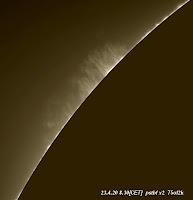*
Tuesday 21st. Another sunny day.


09.00 52/50F, breezy from the east. Straight into the open dome!
A dark smear [filament?] on the NE quadrant. I am going to try different settings to see which produces the best results. 2x WO Barlow for more image scale. I shall label each image to avoid confusion.


I have decided to image the prom at 10 o'clock NE limb.The telescopes are being blown around. So I have screened the lower slit with agricultural 50% green shade netting. It doesn't help all that much even when doubled.


Yesterday was a blank until the late afternoon when the seeing settled. The absence of surface features demands I use my imaging time wisely. There is no point in just sitting there in the observatory capturing endless videos. Not unless something useful comes out of the sausage factory gates.

I keep asking myself how can I improve my final results. Imaging and processing are two very different exercises but both affect the final, still image. Both stages are almost completely routine by now. Perhaps I ought to be improving my routines while there is so little to capture? Practice does not, alas, make perfect. Not unless vital lessons are learned.
I have tried long and short video captures. High gain and no gain. More and less numbers of stacked frames per video. Bright and dim captures. Pushing hard and hardly pushing the processing at all. None of these provides startlingly improved, final images. It is all down to the seeing and having something interesting to capture.
It could easily be argued that I am strictly a one trick pony. I have two, rather large aperture telescopes. One for H-alpha and the other for white light imaging. Large apertures at f/10 have long focal lengths. Which means very high native magnification. Which places much great emphasis on the seeing conditions.
Unless the seeing is near perfect, then all I am doing is amplifying thermal image movement and any lack of clarity. It is true that I can reach down to very small features with my long focal lengths. Even adding a Barlow Lens for further exaggeration. What little I can see of the arc of the entire sun's limb clearly indicates I am capturing features on a circle the size of very large dustbin lid. I keep meaning to make cardboard templates to measure the true image radius on my 27" monitor.
Many solar imagers concentrate on achieving perfect whole disk images. They use much smaller instruments with enough field of view to capture the whole disk in one go. This does not appeal to me, at all. Particularly in the absence of surface features. Besides, the field is already full of highly skilled and well practiced players. I would have to invest in even more equipment. For a task which does not interest me personally.
Animations are one avenue I could explore further. It demands great discipline to center, track and maintain the closest possible similarity between captured videos. Timing and video length must be tightly controlled. It also needs an interesting feature on which to concentrate. Sharply captured proms, raining plasma down to the solar surface, can be quite magical. If only such proms presented themselves often enough to provide a supermodel!
To achieve this at a suitable scale requires perfect seeing and identikit handling of each short video. Tracking must be near perfect or the object centered and oriented perfectly before and during each capture. Focusing must also be perfect and remain the same for reach capture. Processing must not change for each capture. Only then can one start to stitch the whole lot of final images together so that it runs like a believable, continuous video.
*

 Tuesday 28th 53F/45 Talk about a frustrating day! Bright early start but with plates of dense, white cloud.
Tuesday 28th 53F/45 Talk about a frustrating day! Bright early start but with plates of dense, white cloud. 














































